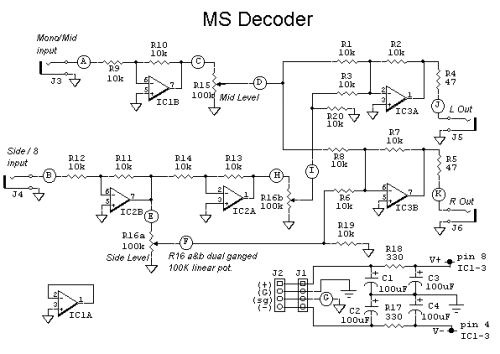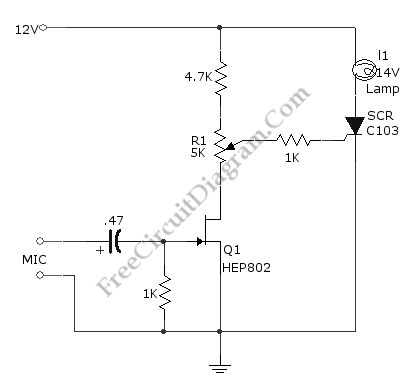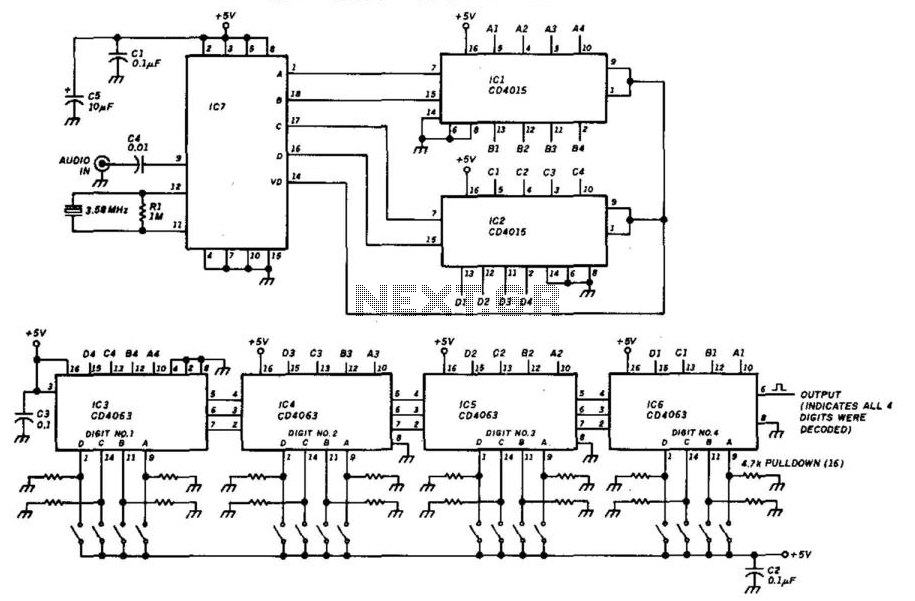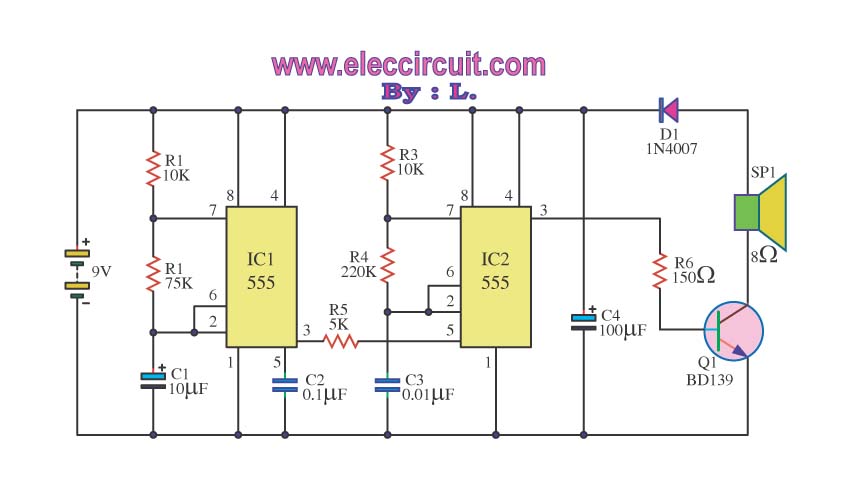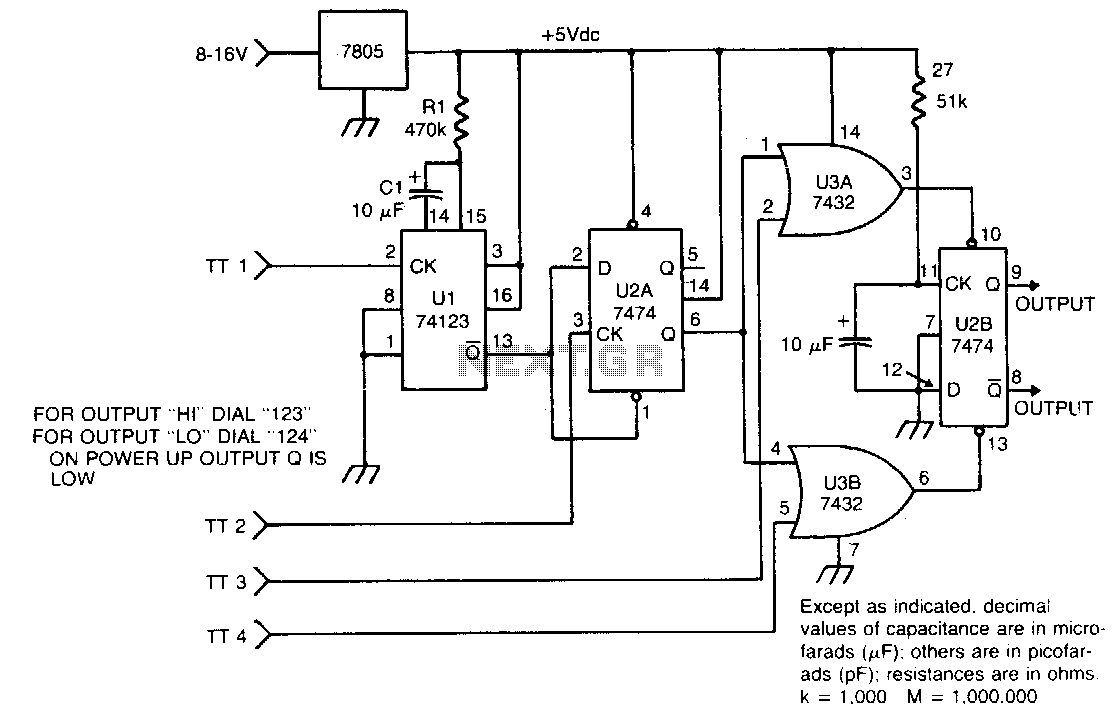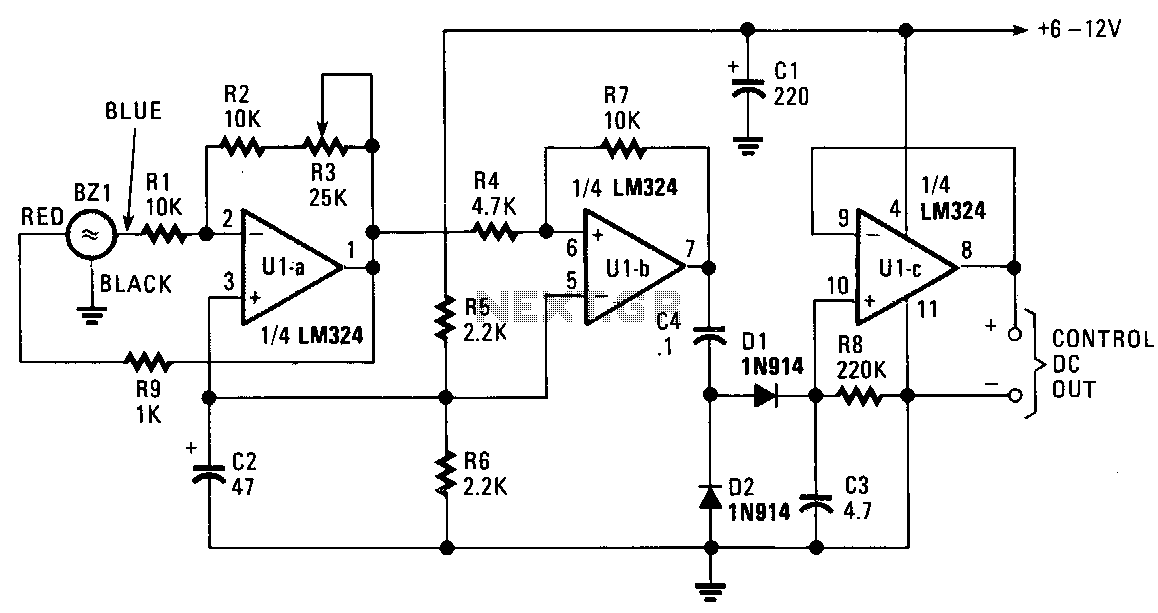
Surround Sound Decoder
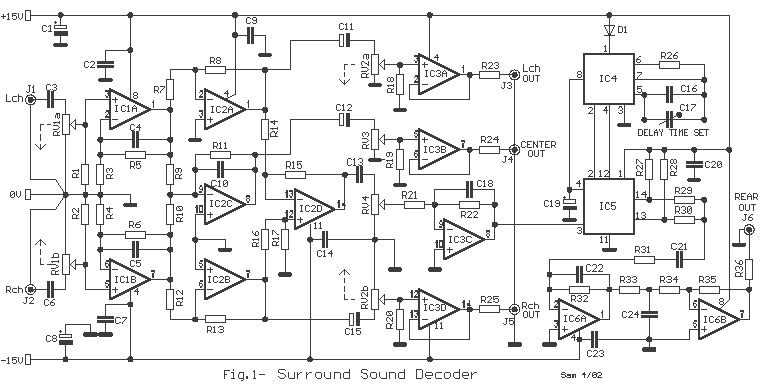
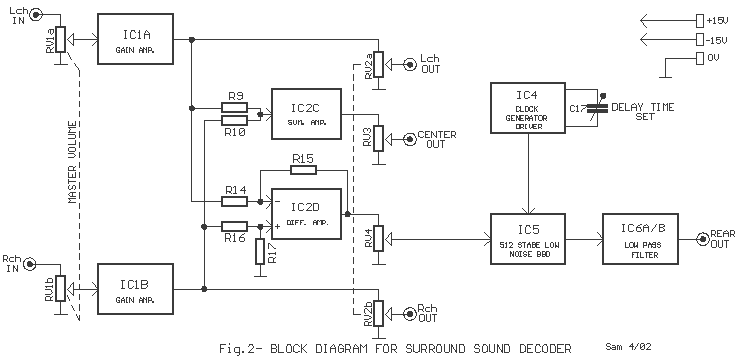
The particular circuit does not have the requirement to replace the trade decoders Surround, because they have many more facilities and possibilities. It gives, however, the possibility in many trials with this article of decoding. The coding in Stereo Dolby Surround shows the tendency to be abandoned and is replaced with digital DTS, Dolby 5.1, etc., that are supported in the digital level of management and transport of sound signals. In order that appears also in the Fig.2, the stereo sound signal that transports the surround information is driven for the Lch in the IC1A and Rch in the IC1B, which are input buffers for the next stages. Then follow the stages of summing [IC2C], which add up the signals of channels L+R and drive them to the output for the central loudspeaker and a differential amplifier [IC2D], which raises the difference of phase L-Rch with which is written in the two channels, the information for Rear loudspeakers. The exit of IC2D drives a regulated delay unit of sound to Rear loudspeakers, so that a sense of space is created and adapted to the size of the room. It is constituted by the IC5, which is an op-amp sound delay signal of 512 stages. The timing of IC5 comes from the IC4, which is an oscillator. The delay time is regulated by variable capacitor C17. In order to cut the noise produced by this process, certain filters are used, which regulate and cut the frequencies above 8kHz and below 100Hz roughly, as larger frequency bandwidth is not needed to drive the Rear loudspeaker. The Rear information is written with a bandwidth of 100Hz to 8kHz; for this reason, the Rear loudspeaker has a small size. These filters are found around the IC6A/B, which is also an output buffer. At all outputs, there are potentiometers that help in the proper level regulation of amplifiers and loudspeakers that follow. It is obvious that each exit should drive a single power amplifier. The circuit is supplied by symmetric voltage ±15V.
The circuit described is a multi-channel audio processing system designed to decode and manage audio signals for surround sound applications. The architecture employs operational amplifiers (op-amps) for signal buffering and amplification, notably using the TL072 and TL074 series for their low noise and high performance in audio applications.
The initial stages of the circuit utilize IC1A and IC1B as input buffers for the left and right channels, respectively. This configuration ensures that the stereo signals are adequately prepared for subsequent processing without introducing significant distortion or noise. The summing amplifier IC2C combines these two channels, producing a central channel output that is essential for a cohesive surround sound experience.
Following this, the differential amplifier IC2D processes the difference between the left and right channels, effectively isolating the phase information necessary for driving rear loudspeakers. This phase information is crucial for creating the spatial effects characteristic of surround sound systems.
A delay unit, realized with IC5, introduces a controlled delay to the rear channels, enhancing the perception of depth and spatial orientation in the audio. The delay is adjustable via a variable capacitor (C17), allowing for customization based on the acoustics of the listening environment. This aspect of the design is particularly important, as it accounts for variations in room size and speaker placement.
Filters surrounding IC6A/B are implemented to manage frequency response, ensuring that only the necessary bandwidth (100Hz to 8kHz) is passed to the rear loudspeakers. This filtering is essential to prevent unwanted high-frequency noise and low-frequency rumble from reaching these speakers, thus optimizing their performance.
The circuit's power supply is designed to provide a symmetric voltage of ±15V, which is critical for the operation of the op-amps and ensures stable performance across the audio spectrum. The inclusion of potentiometers at the outputs allows for fine-tuning of the output levels, facilitating integration with external power amplifiers and loudspeakers.
The comprehensive design and component selection in this circuit reflect a thoughtful approach to achieving high-quality audio processing for surround sound applications, making it suitable for various home theater and professional audio setups. The particular circuit does?t have the requirement to replace the trade decoders Surround, because this they have many more facilities and possibilities. It give however the possibility in many try with this article of decoding. The coding in Stereo Dolby Surround show the tendency to be abandoned and is replaced with digital DTS, Dolby 5.1 etc, that is supported in the digital level of management and transport, sound signal.
In order that appears also in the Fig.2, the stereo sound signal that transport the surround information, is drive for the Lch in the IC1A and Rch in the IC1B, that is input buffer with the next stages. Then follow the stages of summing [ IC2C ], which add up the signals of channels L+R and him drive to the output for central loudspeaker and a differential amplifier [ IC2D ], that rise the difference of phase L-Rch with which is written in the two channels, the information for Rear loudspeakers. The exit of IC2D drive one regulated delay unit of sound to Rear loudspeakers, so that are created the sense of space and her adaptation in the size of our own room.
It?s constituted by the IC5, that is a opamp. sound delay signal of 512 stages. The timing of IC5 becomes from the IC4, that is a oscillator. The delay time is regulated by variable capacitor C17. In order to we cut the noise that is produced by this process exist certain filters then, regulated they cut the frequencies above 8KHZ and under 100 HZ roughly, after we behind did ?t need bigger frequencies bandwidth, to drive the Rear loudspeaker. The Rear information is written with bandwidth of 100HZ until 8KHZ, for this reason Rear loudspeaker has small size.
These filters are found round the IC6A/B, that is output buffer, too. In all the outputs exist potesometer that help in the right level regulation of amplifiers and loudspeakers, that follows. Obvious it?s that each exit should drive single power amplifier .The circuit is supplied by symmetric voltage ± 15V.
Part List R1-2-7-8-12-13-18-19-20=47Kohm C11-12-15=10uF 25V RV1-RV2=2X10Kohm Log. pot. R3-4-5-6-21-22-34-35=10Kohm C13=82nF RV3-4=10K Log pot. R9-10-11-14-15-16-17=15Kohm C16=18pF 100V D1=1N4148 R=23-24-25-33-36=100ohm C17=100pF mini adjustable capacitor IC1-6=TL072 R26-27-28-31-32=100Kohm C18=2.2nF IC2-3=TL074 R29-30=5.6Kohm C19=4.7uF 25V IC4=MN3101 C1-8=47uF 25V C20=100nF 100V IC5=MN3004 C2-7-9-14-23=47nF 100V C21=10nF JI.....J6=RCA female jack C3-6=1uF 100V C22=180pF C4-5-10=33pF 100V C24=150nF 🔗 External reference
The circuit described is a multi-channel audio processing system designed to decode and manage audio signals for surround sound applications. The architecture employs operational amplifiers (op-amps) for signal buffering and amplification, notably using the TL072 and TL074 series for their low noise and high performance in audio applications.
The initial stages of the circuit utilize IC1A and IC1B as input buffers for the left and right channels, respectively. This configuration ensures that the stereo signals are adequately prepared for subsequent processing without introducing significant distortion or noise. The summing amplifier IC2C combines these two channels, producing a central channel output that is essential for a cohesive surround sound experience.
Following this, the differential amplifier IC2D processes the difference between the left and right channels, effectively isolating the phase information necessary for driving rear loudspeakers. This phase information is crucial for creating the spatial effects characteristic of surround sound systems.
A delay unit, realized with IC5, introduces a controlled delay to the rear channels, enhancing the perception of depth and spatial orientation in the audio. The delay is adjustable via a variable capacitor (C17), allowing for customization based on the acoustics of the listening environment. This aspect of the design is particularly important, as it accounts for variations in room size and speaker placement.
Filters surrounding IC6A/B are implemented to manage frequency response, ensuring that only the necessary bandwidth (100Hz to 8kHz) is passed to the rear loudspeakers. This filtering is essential to prevent unwanted high-frequency noise and low-frequency rumble from reaching these speakers, thus optimizing their performance.
The circuit's power supply is designed to provide a symmetric voltage of ±15V, which is critical for the operation of the op-amps and ensures stable performance across the audio spectrum. The inclusion of potentiometers at the outputs allows for fine-tuning of the output levels, facilitating integration with external power amplifiers and loudspeakers.
The comprehensive design and component selection in this circuit reflect a thoughtful approach to achieving high-quality audio processing for surround sound applications, making it suitable for various home theater and professional audio setups. The particular circuit does?t have the requirement to replace the trade decoders Surround, because this they have many more facilities and possibilities. It give however the possibility in many try with this article of decoding. The coding in Stereo Dolby Surround show the tendency to be abandoned and is replaced with digital DTS, Dolby 5.1 etc, that is supported in the digital level of management and transport, sound signal.
In order that appears also in the Fig.2, the stereo sound signal that transport the surround information, is drive for the Lch in the IC1A and Rch in the IC1B, that is input buffer with the next stages. Then follow the stages of summing [ IC2C ], which add up the signals of channels L+R and him drive to the output for central loudspeaker and a differential amplifier [ IC2D ], that rise the difference of phase L-Rch with which is written in the two channels, the information for Rear loudspeakers. The exit of IC2D drive one regulated delay unit of sound to Rear loudspeakers, so that are created the sense of space and her adaptation in the size of our own room.
It?s constituted by the IC5, that is a opamp. sound delay signal of 512 stages. The timing of IC5 becomes from the IC4, that is a oscillator. The delay time is regulated by variable capacitor C17. In order to we cut the noise that is produced by this process exist certain filters then, regulated they cut the frequencies above 8KHZ and under 100 HZ roughly, after we behind did ?t need bigger frequencies bandwidth, to drive the Rear loudspeaker. The Rear information is written with bandwidth of 100HZ until 8KHZ, for this reason Rear loudspeaker has small size.
These filters are found round the IC6A/B, that is output buffer, too. In all the outputs exist potesometer that help in the right level regulation of amplifiers and loudspeakers, that follows. Obvious it?s that each exit should drive single power amplifier .The circuit is supplied by symmetric voltage ± 15V.
Part List R1-2-7-8-12-13-18-19-20=47Kohm C11-12-15=10uF 25V RV1-RV2=2X10Kohm Log. pot. R3-4-5-6-21-22-34-35=10Kohm C13=82nF RV3-4=10K Log pot. R9-10-11-14-15-16-17=15Kohm C16=18pF 100V D1=1N4148 R=23-24-25-33-36=100ohm C17=100pF mini adjustable capacitor IC1-6=TL072 R26-27-28-31-32=100Kohm C18=2.2nF IC2-3=TL074 R29-30=5.6Kohm C19=4.7uF 25V IC4=MN3101 C1-8=47uF 25V C20=100nF 100V IC5=MN3004 C2-7-9-14-23=47nF 100V C21=10nF JI.....J6=RCA female jack C3-6=1uF 100V C22=180pF C4-5-10=33pF 100V C24=150nF 🔗 External reference
